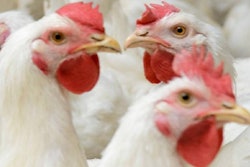
As the U.S. agrifood industry looks at how it can feed a growing global population, the long-term opportunities might be the best for the broiler and turkey industries.
In order to see which types of animal protein have the biggest potential, a person needs to look at where the biggest population increases will be, Jack Britt, principal of Jack H. Britt Consulting, said during the webinar, “How can we ensure a leading role for USA animal protein in the world of the future.”
The webinar was held on April 9 and was presented by the National Institute for Animal Agriculture.
Population boom in Asia, Africa expected
Citing projection figures from the Food and Agriculture Organization of the United Nations (FAO), Britt said by 2068, 93% of the world’s population growth will be in Africa and Asia, and of that 82% of the growth will be in Africa alone.
He added that in both continents, people’s wealth is increasing, which means they will spend “more and more and more on animal products,” said Britt.
Meanwhile, the populations are expected to decline in Europe and only grow modestly in Latin America and North America.
What proteins will be in demand?
“Religion will have an impact on what we can sell to certain countries,” said Britt.
And based on the predominant religions in those world regions, poultry is the only major protein that has the fewest barriers.
“In India, we’re not going to sell much beef, because they don’t consume very much beef,” said Britt, who noted that India’s population is projected to outgrow China’s by 2067. “Their religious beliefs are not to consume beef, or very small amounts.”
He also noted that many of those countries in the growth areas have a heavy Muslim population, including Nigeria, Pakistan, Indonesia and Bangladesh, “so they’re not going to be consuming much pork,” he said.
“That doesn’t mean we can’t feed (people in countries with a high Muslim population) turkey and chicken and beef and dairy products,” said Britt. “We have to balance, I think, our products with what the consumers in those countries are likely to purchase.”
Meeting poultry product expectations
In order to best serve these countries, attention must be paid to what types of products their citizens prefer. Britt advises asking questions and doing research.
“We need to be in those countries, talking to them,” he said, suggesting meat and poultry companies ask questions like what kind of spices they like, how do they like their meat and poultry cooked, and what are the desired portion sizes.
He indicated consumers in Asia and Africa might be accustomed to poultry meat from smaller birds, which is something to keep in mind from both the production and processing angles.
“Will they get accustomed to receiving the same portion sizes we use in our marketplace? We need to be thinking down the road, do we change, or how do we process and make portion sizes acceptable,” Britt said.
















